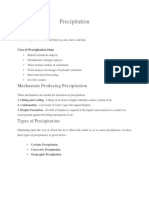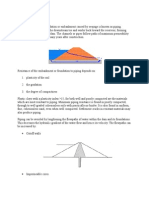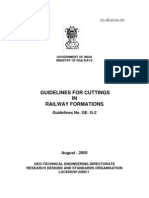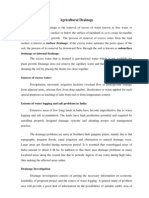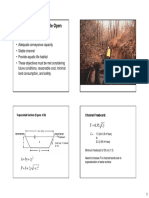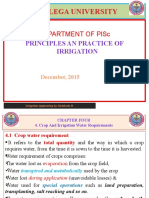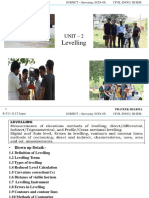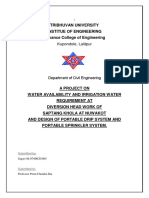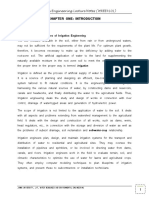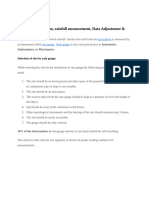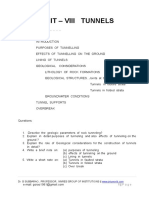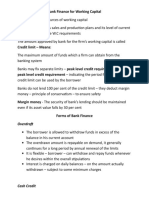Class Note 2 - Rain Gauges
Class Note 2 - Rain Gauges
Uploaded by
Prakash PatelCopyright:
Available Formats
Class Note 2 - Rain Gauges
Class Note 2 - Rain Gauges
Uploaded by
Prakash PatelOriginal Description:
Copyright
Available Formats
Share this document
Did you find this document useful?
Is this content inappropriate?
Copyright:
Available Formats
Class Note 2 - Rain Gauges
Class Note 2 - Rain Gauges
Uploaded by
Prakash PatelCopyright:
Available Formats
Class Notes 2 – Rain Gauges
Rain gauging (Measurement of Rainfall): Rainfall is measured on the basis of the vertical depth of
water accumulated on a level surface during an interval of time, if all the rainfall remained where
it fell. It is measured in mm‘. The instrument used for measurement of rainfall is called “Rain
gauge”.
These are classified as
a. Non recording types
b. Recording types.
a. Non recording type Rain gauges: These rain gauges which do not record the depth of rainfall,
but only collect rainfall. Symon‘s rain gauge is the usual non recording type of rain gauge. It
gives the total rainfall that has occurred at a particular period. It essentially consists of a circular
collecting area 127 mm in diameter connected to a funnel. The funnel discharges the rainfall
into a receiving vessel. The funnel and the receiving vessel are housed in a metallic container.
The components of this rain gauge are a shown in figure below.
Figure: 1Non recording type Rain gauges
SoCE, Dr. C Ramprasad SASTRA University HYDROLOGY
The water collected in the receiving bottle is measured by a graduated measuring jar with an
accuracy of 0.1 ml. the rainfall is measured every day at 8:30 am IST and hence this rain gauge
gives only depth of rainfall for previous 24 hours. During heavy rains, measurement is done 3 to
4 times a day.
b. Recording type Rain gauges: These are rain gauges which can give a permanent, automatic
rainfall record (without any bottle recording) in the form of a pen mounted on a clock driven
chart. From the chart intensity or rate of rainfall in cm per hour or 6 hrs, 12 hrs., besides the
total amount of rainfall can be obtained.
Advantages of recording rain gauges:
1. Necessity of an attendant does not arise
2. Intensity of rainfall at any time as well as total rainfall is obtained, where as non-recording gauge
gives only total rainfall.
3. Data from in accessible places (hilly regions) can be continuously obtained once gauge is
established.
4. Human errors are eliminated.
5. Capacity of gauges is large.
6. Time intervals are also recorded.
Disadvantages of recording rain gauges:
1. High initial investment cost.
2. Recording is not reliable when faults in gauge arise (mechanical or electrical) till faults are
corrected.
Types of recording or automatic rain gauges:
1. Weighing bucket rain gauge: This is the most common type of recording or automatic rain
gauge adopted by Indian Meteorological Department. The construction of this rain gauge is
SoCE, Dr. C Ramprasad SASTRA University HYDROLOGY
shown in figure below. It consists of a receiving bucket supported by a spring or lever. The
receiving bucket is pushed down due to the increase in weight (due to accumulating rain fall).
The pen attached to the arm continuously records the weight on a clock driven chart. The chart
obtained from this rain gauge is a mass curve of rain fall.
Figure 2 Weighing bucket rain gauge
Figure 3 Mass curve of rainfall
SoCE, Dr. C Ramprasad SASTRA University HYDROLOGY
From the mass curve the average intensity of rainfall (cm/hr) can be obtained by calculating the
slope of the curve at any instant of time. The patterns as well as total depth of rain fall at different
instants can also be obtained.
2. Tipping bucket rain gauge: This is the most common type of automatic rain gauge adopted
by U S Meteorological Department.
Figure 4 Tipping bucket rain gauge
This consists of receiver draining into a funnel of 30 cm diameter. The catch (rainfall) from funnel
falls into one of the pair of small buckets (tipping buckets). These buckets are so balanced that
when 0.25 mm of rainfall collects in one bucket, it tips and brings the other bucket into position.
The tipping of the bucket is transmitted to an electricity driven pen or to an electronic counter.
This is useful in remote areas.
SoCE, Dr. C Ramprasad SASTRA University HYDROLOGY
3. Siphon or float type rain gauge: This is also called integrating rain gauge as it depicts an
integrated graph of rain fall with respect to time. The construction of this rain gauge is shown
in figure below.
Figure 5 Siphon or float type rain gauge
A receiver and funnel arrangement drain the rainfall into a container, in which a float mechanism
at the bottom is provided. As water accumulates, the float rises. A pen arm attached to the float
mechanism continuously records the rainfall on a clock driven chart and also produces a mass
curve of rain fall. When the water level rises above the crest of the siphon, the accumulated water
in the container will be drained off by siphonic action. The rain gauge is ready to receive the new
rainfall.
SoCE, Dr. C Ramprasad SASTRA University HYDROLOGY
4. Radar measurement of rainfall: The principle involves RADAR as shown in figure below.
Electromagnetic waves known as pulses are produced by a transmitter and are radiated by a
narrow beam antenna. The reflections of these waves from the targets (echoes) are again
intercepted by the same antenna. A receiver detects these echoes, amplifies and transforms
them into video form on an indicator called Plan Position indicator. The screen of indicator is
illuminated dimly where there is no target (rainfall) and a bright spot occurs where there is a
target and a bright patch where there is an extended object such as rain shower.
SoCE, Dr. C Ramprasad SASTRA University HYDROLOGY
You might also like
- AGR 351 - Soil Water Movement - PPT 1 - Agri JunctionNo ratings yetAGR 351 - Soil Water Movement - PPT 1 - Agri Junction27 pages
- En - 8491 Water Supply Engineering: Unit - 1 Sources of WaterNo ratings yetEn - 8491 Water Supply Engineering: Unit - 1 Sources of Water4 pages
- Civil 4 Sem.: Contouring & Characteristics of ContoursNo ratings yetCivil 4 Sem.: Contouring & Characteristics of Contours30 pages
- Irrigation and Drainage Engineering: Components of An Irrigation SystemNo ratings yetIrrigation and Drainage Engineering: Components of An Irrigation System63 pages
- Assignment No. 1 Hydrology & Water ManagementNo ratings yetAssignment No. 1 Hydrology & Water Management3 pages
- Abdirahiim Yousuf Barre-Full AssignmentNo ratings yetAbdirahiim Yousuf Barre-Full Assignment15 pages
- CE-402: Irrigation Engineering: 8 Semester (4 Year) Civil Engineering Spring 2021No ratings yetCE-402: Irrigation Engineering: 8 Semester (4 Year) Civil Engineering Spring 202123 pages
- 10CV65 - Hydraulic Structures and Irrigation Design - Drawing Question BankNo ratings yet10CV65 - Hydraulic Structures and Irrigation Design - Drawing Question Bank6 pages
- Lab-2: Flow Over A Weir Objectives: Water Resources Engineering Jagadish Torlapati, PHD Spring 2017No ratings yetLab-2: Flow Over A Weir Objectives: Water Resources Engineering Jagadish Torlapati, PHD Spring 20174 pages
- Earth Pressure Theories Rankine's Earth Pressure Theory Active Earth Pressure Passive Earth PressureNo ratings yetEarth Pressure Theories Rankine's Earth Pressure Theory Active Earth Pressure Passive Earth Pressure32 pages
- Types of Irrigation Schemes and Methods of Field Water Application0% (1)Types of Irrigation Schemes and Methods of Field Water Application34 pages
- Chapter One: Introduction: 1.1 Definition and Scopes of Irrigation EngineeringNo ratings yetChapter One: Introduction: 1.1 Definition and Scopes of Irrigation Engineering38 pages
- Cairo University Faculty of Engineering 4 Year Mechanical Power Engineering Department Hydraulic Power StationNo ratings yetCairo University Faculty of Engineering 4 Year Mechanical Power Engineering Department Hydraulic Power Station16 pages
- Roxhill Park Hydrologic Investigation and Recommendations March 2000No ratings yetRoxhill Park Hydrologic Investigation and Recommendations March 200028 pages
- Ecosystem Services of The Congo Basin Forests100% (3)Ecosystem Services of The Congo Basin Forests33 pages
- Analysis of Rainfall Intensity of Kunigal Taluk, Tumkur District, Karnataka Using Gis TechniquesNo ratings yetAnalysis of Rainfall Intensity of Kunigal Taluk, Tumkur District, Karnataka Using Gis Techniques11 pages
- Interrelationship PHASES OF THE HYDROLOGIC CYCLE100% (1)Interrelationship PHASES OF THE HYDROLOGIC CYCLE40 pages
- Development of Reflectivity (Z) and Rainfall Intensity (R) Equation For Short Term Rainfall Forecasting For Northern Region of Peninsular MalaysiaNo ratings yetDevelopment of Reflectivity (Z) and Rainfall Intensity (R) Equation For Short Term Rainfall Forecasting For Northern Region of Peninsular Malaysia43 pages
- Adaptive Crop Agriculture Including Innovative Farming Practices in Haor Basin - 2009100% (1)Adaptive Crop Agriculture Including Innovative Farming Practices in Haor Basin - 200993 pages
- The Lord of The East Wind The Catholic Biblical QuNo ratings yetThe Lord of The East Wind The Catholic Biblical Qu244 pages
- AGR 351 - Soil Water Movement - PPT 1 - Agri JunctionAGR 351 - Soil Water Movement - PPT 1 - Agri Junction
- En - 8491 Water Supply Engineering: Unit - 1 Sources of WaterEn - 8491 Water Supply Engineering: Unit - 1 Sources of Water
- Civil 4 Sem.: Contouring & Characteristics of ContoursCivil 4 Sem.: Contouring & Characteristics of Contours
- Irrigation and Drainage Engineering: Components of An Irrigation SystemIrrigation and Drainage Engineering: Components of An Irrigation System
- CE-402: Irrigation Engineering: 8 Semester (4 Year) Civil Engineering Spring 2021CE-402: Irrigation Engineering: 8 Semester (4 Year) Civil Engineering Spring 2021
- 10CV65 - Hydraulic Structures and Irrigation Design - Drawing Question Bank10CV65 - Hydraulic Structures and Irrigation Design - Drawing Question Bank
- Lab-2: Flow Over A Weir Objectives: Water Resources Engineering Jagadish Torlapati, PHD Spring 2017Lab-2: Flow Over A Weir Objectives: Water Resources Engineering Jagadish Torlapati, PHD Spring 2017
- Earth Pressure Theories Rankine's Earth Pressure Theory Active Earth Pressure Passive Earth PressureEarth Pressure Theories Rankine's Earth Pressure Theory Active Earth Pressure Passive Earth Pressure
- Types of Irrigation Schemes and Methods of Field Water ApplicationTypes of Irrigation Schemes and Methods of Field Water Application
- Chapter One: Introduction: 1.1 Definition and Scopes of Irrigation EngineeringChapter One: Introduction: 1.1 Definition and Scopes of Irrigation Engineering
- Cairo University Faculty of Engineering 4 Year Mechanical Power Engineering Department Hydraulic Power StationCairo University Faculty of Engineering 4 Year Mechanical Power Engineering Department Hydraulic Power Station
- Roxhill Park Hydrologic Investigation and Recommendations March 2000Roxhill Park Hydrologic Investigation and Recommendations March 2000
- Analysis of Rainfall Intensity of Kunigal Taluk, Tumkur District, Karnataka Using Gis TechniquesAnalysis of Rainfall Intensity of Kunigal Taluk, Tumkur District, Karnataka Using Gis Techniques
- Development of Reflectivity (Z) and Rainfall Intensity (R) Equation For Short Term Rainfall Forecasting For Northern Region of Peninsular MalaysiaDevelopment of Reflectivity (Z) and Rainfall Intensity (R) Equation For Short Term Rainfall Forecasting For Northern Region of Peninsular Malaysia
- Adaptive Crop Agriculture Including Innovative Farming Practices in Haor Basin - 2009Adaptive Crop Agriculture Including Innovative Farming Practices in Haor Basin - 2009
- The Lord of The East Wind The Catholic Biblical QuThe Lord of The East Wind The Catholic Biblical Qu




